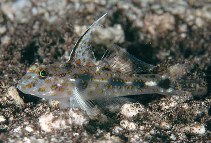| Family: |
Gobiidae (Gobies), subfamily: Gobiinae |
| Max. size: |
4.55 cm SL (male/unsexed) |
| Environment: |
demersal; marine; depth range 2 - 30 m |
| Distribution: |
Indo-West Pacific: Saudi Arabia, Oman, Mauritius, and Kenya (10683); Japan (Ref. 43239) and Indonesia (Ref. 47567). Recently reported from Tonga (Ref. 53797). |
| Diagnosis: |
Dorsal spines (total): 7-7; Dorsal soft rays (total): 9-9; Anal spines: 1-1; Anal soft rays: 7-8; Vertebrae: 26-26. Characterized by semi-translucent body, presence of small orange spots, and 4-5 large internal blackish blotches and rectangular white marks; elongate and filamentous first two dorsal spines especially in male; fully united pelvic fins; presence of pelvic frenum; rounded caudal fin; longitudinal scale series 25-26; ctenoid scales except cycloid on nape, breast and base of pectoral fin; scales absent on operculum; median predorsal scales absent; opening of gill extending to below posterior half of opercle; depth of body 4.8-5.2 in SL (Ref. 90102). |
| Biology: |
Solitary on sand at base of coral overhangs (Ref. 90102). Specimens collected from sand or sand and rubble substrata. |
| IUCN Red List Status: |
Least Concern (LC); Date assessed: 26 June 2018 Ref. (130435)
|
| Threat to humans: |
harmless |
Source and more info: www.fishbase.org. For personal, classroom, and other internal use only. Not for publication.
